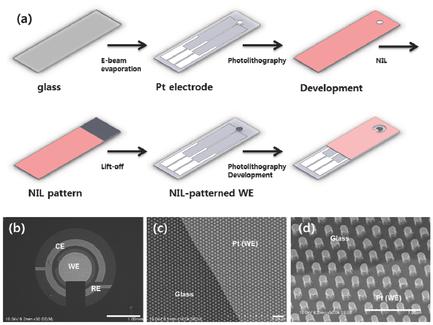当前位置:
X-MOL 学术
›
Adv. Mater. Interfaces
›
论文详情
Our official English website, www.x-mol.net, welcomes your
feedback! (Note: you will need to create a separate account there.)
Fabrication of Pyrrole‐Based Electrochemical Biosensor Platform Using Nanoimprint Lithography
Advanced Materials Interfaces ( IF 4.3 ) Pub Date : 2018-01-15 , DOI: 10.1002/admi.201701593 Junhyoung Ahn 1 , Soongeun Kwon 1 , Sanghee Jung 1 , Wang Sik Lee 2, 3 , Jinyoung Jeong 2, 3 , Hyungjun Lim 1, 3 , Yong-Beom Shin 3, 4 , JaeJong Lee 1, 3
Advanced Materials Interfaces ( IF 4.3 ) Pub Date : 2018-01-15 , DOI: 10.1002/admi.201701593 Junhyoung Ahn 1 , Soongeun Kwon 1 , Sanghee Jung 1 , Wang Sik Lee 2, 3 , Jinyoung Jeong 2, 3 , Hyungjun Lim 1, 3 , Yong-Beom Shin 3, 4 , JaeJong Lee 1, 3
Affiliation

|
Many electrochemical biosensors are developed and widely used for the detection of biological responses. However, there is a limitation like increasing the surface area of the working electrode for the improvement of sensitivity. Nanoimprint lithography (NIL) is a simple method that uses stamp and UV or thermally curable resins for fabricating nanopatterns and nanostructures at low cost and with high throughput and high resolution. Therefore, the fabrication of a nanostructure on the working electrode using nanoimprint lithography can improve not only the sensitivity of a biosensor to biological responses by increasing the surface area of the working electrode but also the mass production of nanopatterned electrodes. Here, a conducting polymer‐based UV‐curable resin is aimed to develop and to use it to fabricate a uniform nanostructure on the working electrode. The 150 nm pillar patterns on a Pt electrode are created using polydimethylsiloxane stamps and KIMM ANT‐6HO UV‐NIL system and measured electrochemical signals using cyclic voltammetry. Furthermore, glucose oxidase is immobilized on the conducting polymer‐imprinted electrode. The developed electrochemical biosensor successfully measures glucose levels across a dynamic range of 0.1 µg mL−1 to 200 mg mL−1 under optimized conditions.
中文翻译:

纳米压印光刻技术制备基于吡咯的电化学生物传感器平台
开发了许多电化学生物传感器,并将其广泛用于生物反应的检测。然而,存在诸如增加工作电极的表面积之类的局限性,以用于提高灵敏度。纳米压印光刻(NIL)是一种简单的方法,使用印模和UV或热固性树脂以低成本,高产量和高分辨率制造纳米图案和纳米结构。因此,使用纳米压印光刻法在工作电极上制造纳米结构不仅可以通过增加工作电极的表面积来提高生物传感器对生物响应的敏感性,而且可以大量生产纳米图案化的电极。这里,一种导电聚合物基可紫外固化树脂旨在开发并用于在工作电极上制造均匀的纳米结构。使用聚二甲基硅氧烷印模和KIMM ANT-6HO UV-NIL系统在Pt电极上形成150 nm的柱状图案,并使用循环伏安法测量电化学信号。此外,葡萄糖氧化酶固定在导电聚合物印迹电极上。研发的电化学生物传感器成功地在0.1 µg mL的动态范围内测量了葡萄糖水平-1至200 mg mL -1在优化条件下。
更新日期:2018-01-15
中文翻译:

纳米压印光刻技术制备基于吡咯的电化学生物传感器平台
开发了许多电化学生物传感器,并将其广泛用于生物反应的检测。然而,存在诸如增加工作电极的表面积之类的局限性,以用于提高灵敏度。纳米压印光刻(NIL)是一种简单的方法,使用印模和UV或热固性树脂以低成本,高产量和高分辨率制造纳米图案和纳米结构。因此,使用纳米压印光刻法在工作电极上制造纳米结构不仅可以通过增加工作电极的表面积来提高生物传感器对生物响应的敏感性,而且可以大量生产纳米图案化的电极。这里,一种导电聚合物基可紫外固化树脂旨在开发并用于在工作电极上制造均匀的纳米结构。使用聚二甲基硅氧烷印模和KIMM ANT-6HO UV-NIL系统在Pt电极上形成150 nm的柱状图案,并使用循环伏安法测量电化学信号。此外,葡萄糖氧化酶固定在导电聚合物印迹电极上。研发的电化学生物传感器成功地在0.1 µg mL的动态范围内测量了葡萄糖水平-1至200 mg mL -1在优化条件下。









































 京公网安备 11010802027423号
京公网安备 11010802027423号